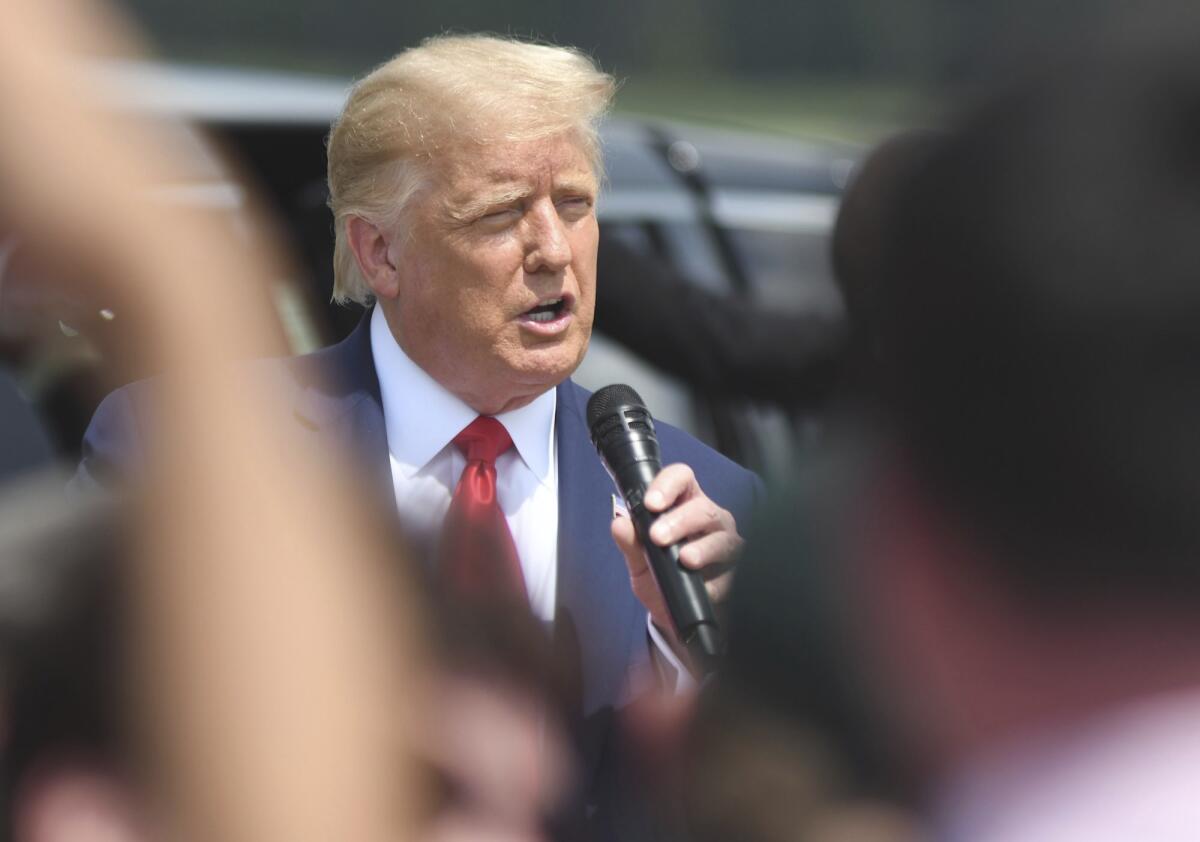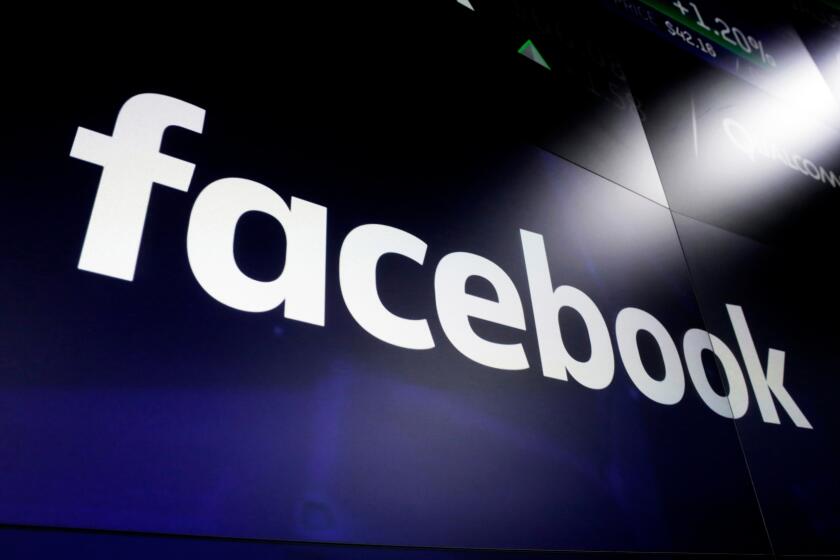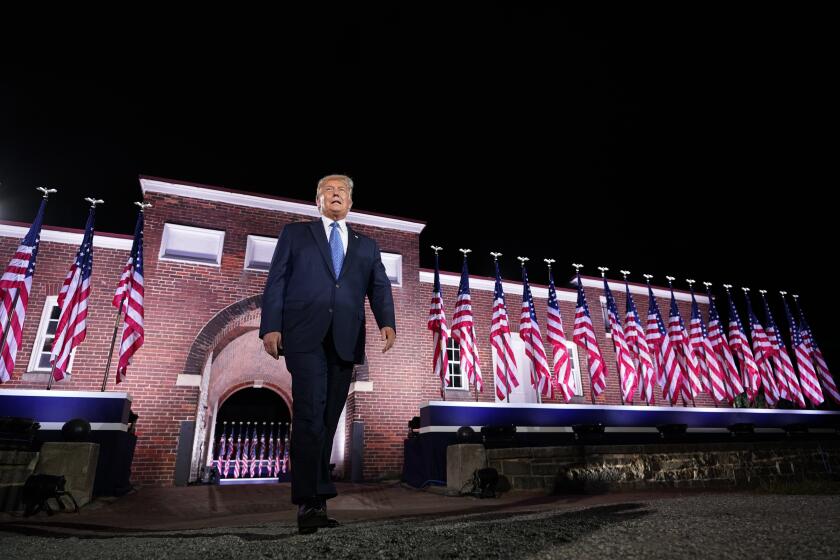Trump faces pushback for seeming to urge people to vote twice as a test

- Share via
WASHINGTON — President Trump said Thursday that people who vote early by mail should show up at their polling places on election day and vote again if their ballots haven’t been counted, a suggestion that experts said would lead to chaos, long lines and more work for election officials during a public health crisis.
In a series of tweets, Trump encouraged voters to go to their polling sites to “see whether or not your Mail In Vote has been Tabulated (Counted). If it has you will not be able to Vote & the Mail In System worked properly.”
But information on whether a ballot has been counted is typically not available right away. In several states, absentee ballots aren’t even counted until after polls close. What can be checked is whether an absentee ballot has been received, and in some cases, whether it has passed a security review and will be submitted for counting.
Election officials warned that a flood of voters showing up on Nov. 3 to check the status of their ballots would mean even more disruption during the coronavirus outbreak and lengthy waits. Karen Brinson Bell, executive director of the North Carolina State Board of Elections, said it also could undermine public health efforts.
The board “strongly discourages” people from following the president’s guidance, Brinson Bell said in a statement. “That is not necessary, and it would lead to longer lines and the possibility of spreading COVID-19.”
Trump’s latest remarks raising questions about the integrity of mail voting came the same day that the Department of Homeland Security sent a memo to election officials warning that “Russia is likely to continue amplifying criticisms of vote-by-mail and shifting voting processes amidst the COVID-19 pandemic to undermine public trust in the electoral process,” according to an official familiar with the memo but not authorized to speak publicly.
With two months left until the presidential election, Facebook says it is taking additional steps to encourage voting and minimize misinformation.
It’s the latest warning by U.S. officials that Russia may be using some of the same criticisms as Trump.
Many states offer ways for voters to verify the status of their ballots online that provide information on when an absentee ballot request is received, when a ballot is sent, when the ballot is received by a local election office and whether it has passed the security review and been accepted. These are typically available on the website of the state election board or the secretary of state.
Voters in the few states that don’t provide this information online have the option to call their local election office.
Trump has for months claimed without proof that there could be widespread voter fraud through mail balloting in November. That’s despite officials in states that have relied on mail-in ballots saying there is little evidence of fraudulent activity. Multiple studies have also debunked the notion of pervasive voter fraud in general and in the vote-by-mail process.
On Wednesday, Trump first seemed to urge absentee voters to go to their polling places on election day to see whether they could vote again. His remarks drew widespread alarm from various officials and voting rights groups, saying that if voters were somehow able to cast a second ballot, they could face prosecution for voting twice.
“Let me be perfectly clear: Voting twice is illegal, no matter who tells you do to it. The president’s idea is a great one for people looking to go to jail,” said Michigan Atty. Gen. Dana Nessel.
Karen Hobert Flynn, president of Common Cause, said: “You cannot test election integrity rules by breaking them, anymore than you can rob a bank to make sure your money is safe.”
White House Press Secretary Kayleigh McEnany blamed the media for taking Trump’s words out of context. She said the president said mail-in voters should go to the polls to make sure their votes got tabulated, and if they weren’t, they should vote in person.
“The president does not condone unlawful voting,” McEnany said.
With the conventions over, President Trump continues to trail Joe Biden. Trump has lost ground among some key blocs of his 2016 vote.
Trump’s tweets on Thursday appeared to be an effort to clarify the earlier remarks. But they continued to cause concern for election officials who would have to deal with voters showing up at polling places on election day to demand information on their absentee ballots.
All states track absentee ballots, so they know which voters have requested an absentee ballot and, of those, how many have returned their ballots. This information is available to poll workers on election day for the check-in process, either through paper or electronic poll books.
If a voter shows up at a polling place on election day after having requested an absentee ballot, this will be readily apparent. Depending on state rules a voter might be able to cancel their absentee ballot, but some might be instructed to cast a provisional ballot that will trigger a review process to determine whether the person is a valid voter and whether their absentee ballot was received and counted.
Provisional ballots are the last to be reviewed and counted. If a voter’s absentee ballot was not counted, their provisional ballot would be counted.
Having large numbers of people casting provisional ballots would create long lines at polling places on election day because it’s more time-consuming for poll workers to conduct than issuing a regular ballot. Once polls close, it’s much more work for election officials.
“It’s just going to increase the strain on the system,” said Jennifer Morrell, a former election official in Colorado and Utah. “All those provisional ballots that have been issued, they are all going to have to be researched. You need to be so thorough. You don’t want to disenfranchise anyone who has the right to vote and you also don’t want to let a vote be processed if it shouldn’t be.”
More to Read
Get the L.A. Times Politics newsletter
Deeply reported insights into legislation, politics and policy from Sacramento, Washington and beyond. In your inbox three times per week.
You may occasionally receive promotional content from the Los Angeles Times.












